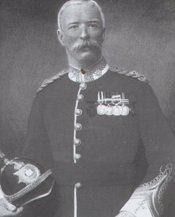Role Armed force officer | Name James Ignatius Rank Major | |
 | ||
Years of service 1881 - 1912, 1914 - 1915 Battles/wars 1882 Anglo-Egyptian WarTirah CampaignSecond Boer WarWorld War I Place of burial Waterlooville, United Kingdom Similar People Albert Halton, Thomas Grady, Harry Christian, James Miller | ||
Major James Edward Ignatius Masterson VC (20 June 1862 – 24 December 1935) was an Irish recipient of the Victoria Cross, the highest and most prestigious award for gallantry in the face of the enemy that can be awarded to British and Commonwealth forces.
Contents
Early career
Masterson entered the Royal Irish Fusiliers in 1881, and served in the 1882 Anglo-Egyptian War, including the Battle of Tel-el-Kebir. He was commissioned a second lieutenant in the Devonshire Regiment on 15 July 1891, served in Burma from 1891 to 1892, and was promoted to lieutenant on 16 April 1895. From 1897 to 1898 he served with the 1st battalion of his regiment in the Tirah Campaign in the North-West Frontier of India under Sir William Lockhart.
Second Boer War
The Second Boer War broke out in South Africa in October 1899, and the British government soon realized they would need more troops. Masterson arrived in late 1899 with his regiment, and were involved in the Relief of Ladysmith.
Victoria Cross
Masterson was 37 years old, and a lieutenant in the 1st Battalion, Devonshire Regiment, when the following deed took place on 6 January 1900, at Wagon Hill, Ladysmith, South Africa for which he was awarded the VC:
During the action at Wagon Hill, on the 6th January, 1900, Lieutenant Masterson commanded, with the greatest gallantry and dash, one of the three companies of his regiment which charged a ridge held by the enemy and captured their position.
The companies were then exposed to a most heavy and galling fire from the right and left front. Lieutenant Masterson undertook to give a message to the Imperial Light Horse, who were holding a ridge some hundred yards behind, to fire to the left front and endeavour to check the enemy's fire.
In taking this message he crossed an open space of a hundred yards which was swept by a most heavy cross fire, and although badly wounded in both thighs, managed to crawl in and deliver his message before falling exhausted into the Imperial Light Horse trench. His unselfish heroism was undoubtedly the means of saving several lives.
He was severely wounded during the action, and placed in a field hospital. In February 1900 he was promoted to captain (the appointment was dated back to 1 January 1900).
Later career
He transferred to the King's Own Royal Lancaster Regiment as a Major in 1911 and retired in 1912. In 1914 he returned to the Army as a Deputy Director of Railway Transport. He died at Waterlooville, Hampshire, England, on 24 December 1935, aged 73.
His Victoria Cross is displayed at the Military Museum of Devon and Dorset, Dorchester, Dorset, England.
His ancestor, also surnamed Masterson, captured a Napoleonic eagle at Barossa in 1811 and was given a field commission - this is portrayed in Bernard Cornwell's Sharpe's Fury
